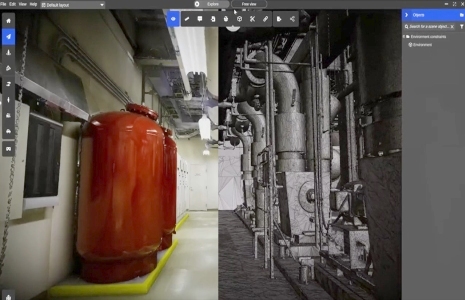
Traditional pathways for creating, using, and sharing modeled 3D reality data presents challenges to broader adoption. Montreal-based Prevu3D provides a unique solution to remove those barriers.
Reality capture has become easier and less expensive than even a few years ago. Drone based photogrammetry and LiDAR, terrestrial, mobile, and even backpack LiDAR, hand-held photogrammetry and SLAM LiDAR… And what’s more is that these mass-data-capture tools can often be operated with a minimum of training (though not always successfully) by just about anyone. This wave of professional and “prosumer” reality capture devices means rapid point clouds—lots and lots of point clouds. Great, but the next step is not necessarily as simple or inexpensive: creating useful models from the point clouds. And even when created, you might need to import into a high-end software environment for just about any end use thereof.
There are a lot of applications and services that can create a simplified 3D model from your point clouds. Yet in some cases, the resultant models are in a raw state, like the points clouds themselves. Mostly, it takes ingestion into sophisticated design or analysis software suites before specific segments of the infrastructure life cycle can make full use of the models. Traditionally, options for pipelining models into CAD, GIS, BIM, and engineering environments have been limited, and often required specific skills. Those paths can carry a lot of overhead. All of this is changing, with the arrival of specialized tools that provide intelligence to make reality capture data more usable and consumable. This is not a niche; it is more like a chasm of missed opportunity.
What impresses us about Prevu3D, a Canadian geospatial tech solutions and services firm, is that they are making great headway towards bridging that chasm. They have a product that can rapidly create meshed 3D models from your point clouds, but also provide tools to add attribution, perform 3D planning, simulations, and certain design steps, analysis, and even remote collaboration & sharing.

For example: you have a facility or site, and you want to perform asset management tasks, space planning, or examine pre-design alternatives. You can do all of these in the full-color mesh model that Prevu3D produces from your point cloud, using their desktop or online applications. You can make this available to your whole team, clients, even present accessible models to the public.
Picture a fully meshed and colorized plant, where you can cut out sections of the mesh as objects, like pumps and tanks, rearrange them, or add new equipment from imported 3D models. Then you can do walkthroughs (with walking avatars) with the plant operators and owners. Or say you need to plan materials staging for a construction site. For these and many other scenarios Prevu3D’s customers have presented, many can be done without necessarily having to go full-on in a high-end legacy modeling environment.
What is Prevu3D, and how does it work? We spoke with Nicolas Morency, Prevu3D founder and CEO. Morency has a background in R&D in the field of mechanical engineering. “We started in December of 2017 with a focus on the engineering that needed to be done,” says Morency. “We’re still mostly engineers: 25 now. The market for this kind of solution was just opening up then, and we were lucky to have enough inbound opportunities while we developed our solution and grew the business.”

Prevu3D has been recognized for its innovation and identified for assistance by the tech accelerator Centech. A key early project was a collaboration with the Port of Montreal: creating a 3D model of the full 26-kilometer length of the port to help plan for an upcoming exhibition. The accuracy and detail of the model gained a lot of attention, and a deputy harbormaster had the idea of also using the model as a setting for digital fire and safety training. This is a perfect example of what happens when 3D reality models reach the hands of many more people: the applications can multiply. Morency says that indeed, they are seeing positive growth in several sectors, especially plant and industrial, but “there’s still a lot of education to be done when it comes to using reality capture data better.”
A customer’s first step is to upload their point clouds via the Prevu3D portal—just about any industry point cloud format. Prevu3D creates a meshed model, that you could export in many industry standard formats, for import into other environments, or you can work in their application with tools provided for many end uses.
“In the app, you can take a section of, or the entire space, and export it in many formats,” says Morency. “For instance, you can export it in DXF with vertex colors, or other formats like OBJ, GLB, or others—there’s most likely support for any file format that will fit the customer’s need.” Typically, large meshes are still not well supported in some external applications, so you can simplify the model (decimate it) in Prevu3D if needed.
The desktop application has a growing suite of tools: for measurements, documentation, notations, and virtual cleanup of spaces. And you can take cut sections of the model and move them around, like in a plant where you might want to move machinery out of the way to look at a redesign of what’s behind them. You can import models of new machinery, furniture, HVAC components, pipes, etc. The same can be done with AEC site plans, store fixtures, warehouses, public spaces, and more. So many more applications that can be done without necessarily having to move the data into a highly-specialized tool.

Prevu3D recognized some market segments, like industrial sites, were still mostly working in 2D environments for many tasks, due to the cost and difficulty of going 3D—this was a market they wanted to pursue. “You’re able to use reality so you don’t have to remodel everything existing in traditional BIM tools,” says Morency. “Then you can import the new objects. You leverage what CAD does best, which is at the equipment level, and then use reality capture to put all the context and the reference measurements.” Then there are the export options, and you can share the edited space in a collaborative viewer.
The detail of the models depends on the quality and resolution of the input points clouds, but as Morency notes: “We create meshes that have up to 12 levels of detail, and we apply high resolution textures on them, which is not always the standard in many meshed models.” As Prevu3D continues to add functionality, they are applying AI to further automate things like classification and segmentation of spaces systematically, at the asset level.
The foundational elements of 3D reality models are highly evolved, yet today the actual use and application is relatively limited—special software, applications, and skillsets are required. By contrast, the means to capture 3D data is quite democratized. Easy to capture, hard to model—this can present a bottleneck. Prevu3D has developed products to help alleviate this bottleneck. If the means to create models from captured data is automated as-a-service, with tools to work with the model for a growing number of applications, that is a great start. Remember when everyone got a real-time map on their phones? That spurred new industries that would not have otherwise existed without ubiquitous location-tech. While rapid and accessible reality models in the hands of many more people may not reach that level of impact, who knows just how many end uses and further innovation this kind of thing could spur. After all, popularized aspirations for “metaverses” will not be realized without a lot of reality modeling, and that is not going to be practical relying solely on legacy data pathways. It is great to see steps forward.





Be the first to comment